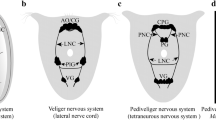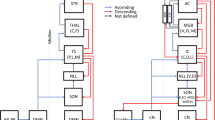Summary
The morphological features of descending interneurons that responded to the artificial bending of statolith hairs were assessed with intracellular recording and staining techniques. Seven statocyst interneurons were identified on the basis of their structure and response characteristics and designated as interneurons S1 to S7. All seven identified interneurons project to the optic lobe, where the optic nerve also projects, and to the dorsal part of the tritocerebrum, where the eyestalk motoneurons originate. All except interneuron S6 also extend their major branches to other neuropilar regions. S2 projects to the dorsal part of the deutocerebrum, where the statocyst nerve terminates, and S3 to the dorsal part of deutocerebrum and the antennal lobe. Four other interneurons (S1, S4, S5, S7) also extend their branches to the parolfactory lobe to which the statocyst nerve projects as well as to the deutocerebrum and antennal lobe. The extensive dendritic projections of S1–S7 suggest that they are complex multimodal interneurons rather than simple relay interneurons, receiving at least visual and statocyst sensory information. The function of the antennal lobe branches, however, has yet to be determined since the functional role of antennal input in equilibrium control is unknown.
Similar content being viewed by others
References
Alverdes F (1926) Stato-, Photo- und Tangoreactionen bei zwei Garneelenarten. Z Vergl Physiol 4:699–765
Bacon JP, Altman JS (1977) A silver intensification method for cobalt-filled neurons in wholemount preparations. Brain Res 138:359–363
Bethe A (1897) Das Nervensystem von Carcinus maenas, ein anatomischphysiologischer Versuch. I. Theil, II. Mittheil. Arch Mikr Anat 50:589–639
Davis WJ (1971) The integrative action of the nervous system in crustacean equilibrium reactions. In: Gordon SA, Cohen MJ (eds) Gravity and the organism. Chicago University Press, Chicago, pp 237–250
Glantz RM, Kirk M, Viancour T (1981) Interneurons of the crayfish brain: the relationship between dendrite location and afferent input. J Neurobiol 12:311–328
Habig C, Taylor RC (1982) The crayfish second antennae. II. Motoneuron structure as revealed by cobalt chloride backfilling. Comp Biochem Physiol [A] 72:349–358
Hanström B (1925) The olfactory centers in crustaceans. J Comp Neurol 38:221–250
Hanström B (1948) The brain, the sense organs and the incretory organs of the head in the Crustacea Malacostraca. Bull Biol Suppl 33:98–126
Harreveld A van (1936) A physiological solution for freshwater crustaceans. Proc Soc Exp Biol Med 34:428–432
Hisada M (1975) Gravitational and visual control of eye movement in crayfish. Fortschr Zool 23:162–173
Kennedy D (1971) Crayfish interneurons (15th Bouditch Lecture). Physiologist 14:5–30
Kinnamon JC (1979) Tactile input to the crayfish tegumentary neuropile. Comp Biochem Physiol [A] 63:41–50
Kühn A (1914) Die reflektorische Erhaltung des Gleichgewichtes bei Krebsen. Verh Dtsch Zool Ges 24:262–277
Mellon F De (1977) The anatomy and motor nerve distribution of the eye muscles in the crayfish. J Comp Physiol 121:349–366
Neil DM (1985) Multisensory interactions in the crustaceans equilibrium system. In: Barnes WJP, Gladden M (eds) Feedback and motor control in invertebrates and vertebrates. Croom Helm, London, pp 277–298
Neil DM, Schöne H, Scapini F, Miyan JA (1983) Optokinetic responses, visual adaptation and multisensory control of eye movements in the spiny lobster, Palinurus vulgaris. J Exp Biol 107:349–366
Schöne H (1951) Die statische Gleichgewichtsorientierung dekapoder Crustaceen. Verh Dtsch Zool Ges 16:157–162
Schöne H (1954) Statocystenfunktion und statische Lageorientierung bei dekapoden Krebsen. Z Vergl Physiol 36:241–260
Schöne H, Schöne H (1967) Integrated function of statocyst and antennular proprioceptive organ in the spiny lobster. Naturwissenschaften 54:289–290
Schöne H, Neil DM, Scapini F, Dreissmann G (1983) Interaction of substrate, gravity and visual cues in the control of compensatory eye responses in the spiny lobster, Palinurus vulgaris. J Comp Physiol 150:23–30
Stein A (1975) Attainment of positional information in the crayfish statocyst. Fortschr Zool 23:109–119
Suzuki Y, Hisada M (1979) Abdominal abductor muscle in crayfish: physiological properties and neural control. II. Abdominal movements. Comp Biochem Physiol [A] 62:841–846
Takahata M, Hisada M (1979) Functional polarization of statocyst receptors in the crayfish Procambarus clarkii Girard. J Comp Physiol 130:201–207
Takahata M, Hisada M (1982) Statocyst interneurons in the crayfish Procambarus clarkii Girard. I. Identification and response characteristics. J Comp Physiol 149:287–300
Tautz J, Tautz RM (1983) Antennal neuropile in the brain of the crayfish: morphology of neurons. J Comp Neurol 218:415–425
Taylor RC (1968) Water-vibration reception: a neurophysiological study in unrestrained crayfish. Comp Biochem Physiol 27:795–805
Tyrer NM, Bell EM (1974) The intensification of cobalt-filled neurone profiles using a modification of Timm's sulphide-silver method. Brain Res 73:151–155
Wiersma CAG (1958) On the functional connections of single units in the central nervous system of the crayfish, Procambarus clarkii (Girard). J Comp Neurol 110:421–471
Wiersma CAG, Bush BMH (1963) Functional neuronal connections between the thoracic and abdominal cords of the crayfish, Procambarus clarkii (Girard). J Comp Neurol 121:207–235
Wiersma CAG, Mill PJ (1965) “Descending” neuronal units in the commissure of the crayfish central nervous system; and their integration of visual, tactile and proprioceptive stimuli. J Comp Neurol 125:67–94
Yoshino M, Takahata M, Hisada M (1980) Statocyst control of the uropod movements in response to body rolling in crayfish. J Comp Physiol 139:243–250
Yoshino M, Kondoh Y, Hisada M (1983) Projection of statocyst sensory neurons associated with crescent hairs in the crayfish Procambarus clarkii Girard. Cell Tissue Res 230:37–48
Author information
Authors and Affiliations
Rights and permissions
About this article
Cite this article
Nakagawa, H., Hisada, M. Morphology of descending statocyst interneurons in the crayfish Procambarus clarkii Girard. Cell Tissue Res. 255, 539–551 (1989). https://doi.org/10.1007/BF00218789
Accepted:
Issue Date:
DOI: https://doi.org/10.1007/BF00218789




